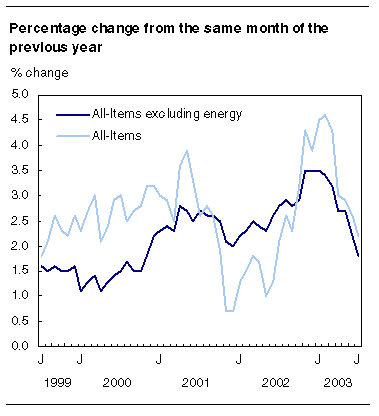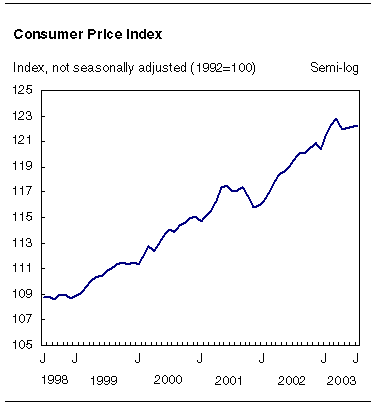
















 |
|
 |                |
Information identified as archived is provided for reference, research or recordkeeping purposes. It is not subject to the Government of Canada Web Standards and has not been altered or updated since it was archived. Please "contact us" to request a format other than those available.

|

Tuesday, August 19, 2003 Consumer Price IndexJuly 2003The price consumers paid for the goods and services contained in the Consumer Price Index (CPI) basket edged up 0.1% for the third consecutive month, contributing to lowering the 12-month percentage change between July 2002 and July 2003 to 2.2%. This is the smallest increase since July 2002. The CPI excluding energy increased 1.8% from July 2002 to July 2003, after rising 2.2% in June. The majority of the 12-month advance in the CPI was due to increases within the shelter and transportation components. Within shelter, upward pressure came from natural gas and homeowners' replacement cost, while for transportation it came from higher automotive vehicle insurance premiums. Last September's tuition fee increases along with higher prices for food purchased from restaurants and cigarettes also contributed to the 12-month increase. A large part of the upward movement in these categories occurred earlier in the 12-month period. In July 2003, natural gas prices were 55.8% higher than in July 2002. This mainly reflects the fact that the level of the index was unusually low last year due to the effects of a payment to northern Alberta customers following the sale of a gas field. 
Most of the downward pressure came from lower prices for traveller accommodation, clothing and footwear. Traveller accommodation prices were 14.4% below July 2002 levels, as the tourism industry faced the effects of a higher Canadian dollar, along with the outbreak of severe acute respiratory syndrome (SARS) in Toronto and a general economic slowdown. The CPI rose slightly from June to JulyThe CPI rose slightly from June to July, up 0.1% for the third consecutive month. Increases in gasoline, men's clothing and air transportation prices were almost entirely offset by price decreases for automotive vehicle purchases and beef. Gasoline prices increased on average 1.9% from June to July. Gasoline prices were up in all provinces except Prince Edward Island (-0.1%), where prices are regulated. Price increases ranged from 0.2% in Alberta to 6.5% in Nova Scotia. After dropping 5.1% in June, the index for men's clothing rebounded 3.4%, as widespread sales came to an end. Price increases for men's clothing normally occur in July, but like the downward movement last month, were more substantial than usual. For a third month this year, the overall clothing index has reached a level as low as those last seen in 1992. 
Air transportation costs climbed 3.1% from June to July. Increases are typical in July, reflecting in large part the peak season for travellers. The advance registered this year is, however, smaller than usual, as July's increases over the previous three years have averaged 9.0%. Prices for the purchase of automotive vehicles were down 0.9% in July, following a 1.5% decrease in June, primarily a result of additional incentives from automotive vehicle manufacturers. The index for the purchase of automotive vehicles is now at its lowest level since October 1997. Beef prices fell 5.0% in July. This was the largest monthly decrease since the mid-seventies. While there were seasonal specials, most of the downward pressure came from price decreases for cuts Canada normally produces for export. The price reductions were the result of trade restrictions on Canadian beef by the United States and other countries triggered by the May 20 discovery of a case of bovine spongiform encephalopathy (BSE) in Alberta. Price declines were greatest in Western Canada, with Alberta beef prices falling 16.4%. The seasonally adjusted CPI increased slightly from June to JulyAfter correcting for seasonal influences, the All-items CPI rose 0.1% from June to July. The increase in the seasonally adjusted index for July is attributable to the rise in the indexes for transportation (+0.3%), health and personal care (+0.3%), alcoholic beverages and tobacco products (+0.2%) and food (+0.1%). These increases were almost entirely offset by the decrease in the seasonally adjusted indexes for recreation, education and reading (-0.3%), clothing and footwear (-0.3%) and shelter (-0.1%). The household operations and furnishings index was unchanged after seasonal adjustment. All-items excluding the eight most volatile componentsThe All-items index excluding the eight most volatile components as defined by the Bank of Canada rose 1.8% from July 2002 to July 2003, the smallest 12-month advance since January 2002. This follows a 12-month increase of 2.1% in June. The main contributors to July's rise were higher automotive vehicle insurance premiums (+22.1%), homeowners' replacement cost (+6.0%) and the increase in tuition fees (+4.8%) registered last September. The All-items index excluding the eight most volatile components as defined by the Bank of Canada remained unchanged from June to July. In large part, drops in the purchase price for automotive vehicles were offset by price increases for men's clothing and cablevision. EnergyIn July, energy prices were 6.7% higher than in July 2002. The majority of this increase is attributable to the rise in the price of natural gas (+55.8%). Higher prices for fuel oil (+10.5%) also contributed to the increase, while lower prices for electricity (-2.6%) and gasoline (-0.1%) exerted some downward pressure. Consumers paid 0.4% more for energy in July than in June. Higher gasoline prices (+1.9%) were partly offset by lower prices for electricity (-0.9%) and natural gas (-0.9%). Available on CANSIM: tables 326-0001, 326-0002, 326-0009, 326-0012 and 326-0016 to 326-0018. Definitions, data sources and methods: survey number 2301. Available at 7 a.m. on Statistics Canada's website (). From the home page, chooseToday's news releases from The Daily, then Latest Consumer Price Index. The July 2003 issue of the Consumer Price Index (62-001-XPB, $11/$103) will be available soon. The August 2003 Consumer Price Index will be released on September 23, 2003. For more information, or to enquire about the concepts, methods or data quality of this release, contact Joanne Moreau (613-951-7130), Prices Division.
| ||||||||||||||||||||||||||||||||||||||||||||||||||||||||||||||||||||||||||||||||||||||||||||||||||||||||||||||||||||||||||||||||||||||||||||||||||||||||||||||||||||||||||||||||||||||||||||||||||||||||||||||||||||||||||||||||||||||||||||||||||||||||||||||||
|
|
|